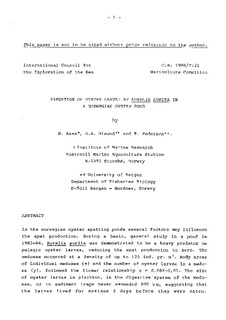| dc.contributor.author | Aase, Hans | |
| dc.contributor.author | Misund, Ole Arve | |
| dc.contributor.author | Pedersen, Torstein | |
| dc.date.accessioned | 2012-07-03T09:26:56Z | |
| dc.date.available | 2012-07-03T09:26:56Z | |
| dc.date.issued | 1986 | |
| dc.identifier.citation | This report is not to be cited without prior reference to the authors | no_NO |
| dc.identifier.uri | http://hdl.handle.net/11250/104157 | |
| dc.description.abstract | In the norwegian oyster spatting ponds several factors may influence
the spat production. During a basic, general study in a pond in
1983-84, Aurelia aurita was demonstrated to be a heavy predator on
pelagic oyster larvae, reducing the spat production to zero. The
medusae occurred at a density of up to 125 ind. pr. m 3. Body areas
of individual medusae (x) and the number of oyster larvae in a medusa
(y), followed the linear relationship y = 0.08X-0,01. The size
of oyster larvae in plankton, in the digestive system of the medusae,
or in sediment traps never exceeded 200 ll m, suggesting that
the larvae lived for maximum 3 days before they were eaten. | no_NO |
| dc.language.iso | eng | no_NO |
| dc.publisher | ICES | no_NO |
| dc.relation.ispartofseries | ICES CM Documents;1986/F:21 | |
| dc.subject | oysters | no_NO |
| dc.subject | østers | no_NO |
| dc.subject | marine environment | no_NO |
| dc.subject | havmiljø | no_NO |
| dc.title | Predation of oyster larvae by Aurelia aurita in a Norwegian oyster pond | no_NO |
| dc.type | Working paper | no_NO |
| dc.subject.nsi | VDP::Agriculture and fishery disciplines: 900::Fisheries science: 920::Resource biology: 921 | no_NO |
| dc.subject.nsi | VDP::Mathematics and natural science: 400::Geosciences: 450::Oceanography: 452 | no_NO |
| dc.subject.nsi | VDP::Mathematics and natural science: 400::Zoology and botany: 480::Marine biology: 497 | no_NO |
| dc.source.pagenumber | 16 s. | no_NO |
